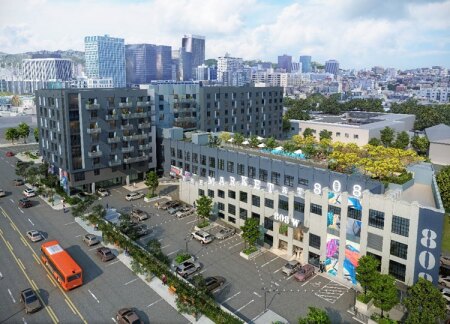
KTGY’s design of Western Station for Jamison Properties LLP in Los Angeles incorporates a parking garage (rehabilitated for parking, retail, and rooftop amenities) with new multifamily housing. With 139 spaces, the project contains at 0.5 space per unit, below normal for Los Angeles because of incentives from the Metropolitan Transit Authority. (KTGY)
It is well established that California suffers one of the most pernicious housing crises among the states. Rampant unaffordability, ever-increasing numbers of unhoused, and battles between housing advocates and neighborhood opponents are rampant. But recently the state has taken robust legislative steps toward stemming these calamities.
“Within the three weeks after the most recent legislative session, Governor Gavin Newsom signed no less than 37 bills aimed at housing regulation and local control,” says David P. Waite, partner, Los Angeles office of Cox Castle Nicholson, and former ULI Los Angeles chair. “It’s part of his mandate as re-elected governor and he’s all over it, very aggressively.”
While Waite believes some of these bills will become tied up in the courts, one piece of legislation holds fascinating promise. Assembly Bill (AB) 2097 removes minimum parking requirements for housing developments within one-half mile (0.8 km) of a major transit stop. As Waite says, “That can be a metro station, it can even be a bus line at the intersection of two bus lines with 15-minute headways. So essentially, that’s taking away parking requirements in the major metros.”
Prior to this long-sought legislation, cities could require developers to provide a least one parking space per tenant. For decades, this drove up the cost and timelines of building, and likewise increased rents and mortgages.
Parking Policy Innovations (2021)
“Overparked” Cities Remove Mandates
In addition to California’s statewide move, major cities have already removed many parking mandates. San Jose, which studies have shown to be one of the most “overparked” cities in the state, recently reversed its policy requiring extensive parking for both commercial and residential development. San Francisco and San Diego recently eliminated parking minimums altogether. In 2016, Oakland removed parking requirements near major transit corridors. Los Angeles has no citywide elimination of mandates, but does encourage significantly reduced parking at affordable/supportive housing developments and transit-oriented developments.
Michael Manville, associate professor of urban planning at the UCLA Luskin School of Public Affairs, recently presented a paper to UCLA Ziman Center for Real Estate about the benefits of removing parking requirements.
“A sizable [amount of] research literature suggests they undermine housing affordability, encourage driving, and discourage walking and public transit use,” states Manville. “Rolling these requirements back is thus a big change, and essential to meeting California’s affordability and sustainability goals.”
Parking Flexibility
Importantly, the new law does not forbid parking, it simply gives developers the option. If they believe their project will be more successful with partial or complete parking, they are free to create it. (They may, however, still face prohibitive community and lender resistance.)
Past mandates often reduced the number of units for which a parcel is nominally zoned, says Manville. For example, a parcel zoned to allow 20 units may have been reduced to 15 units because the mandates made it impossible—financially or logistically—to fit 20 units plus their required parking spaces onto the lot.
At worst, parking requirements can make redevelopment on some parcels completely infeasible. This is more likely to happen with smaller, infill parcels with little room to hold required parking.
“Losing a few housing units here and there, or even the occasional parcel, may not seem like a big deal. Multiplied over many years and many thousands of parcels, however, these small losses add up, yielding the quiet epidemic of underdevelopment that birthed California’s housing crisis.”
While impacts won’t be immediate, Manville believes one major benefit will be an increase in “missing middle” housing. This may include popular typologies that have become rare under California’s parking mandates: streetfront townhomes, garden apartments, four-plexes, bungalow courts, and loft-style apartment buildings. In many cases, these types offer larger units or may blend easily with single-family neighborhoods.
Attainable Designs for the “Missing Middle”
Missing middle homes—aimed at neither the luxury nor affordable renters, but the vast market in between—have largely vanished in many cities. Larger or institutional developers gravitate toward single-family homes or large apartment buildings. (Affordable housing is largely a separate animal with its own financing and statutory constraints.)
“It’s been a long time since we’ve built gentle density at any scale,” says Manville. “Large, established developers generally build single-family homes or large apartment buildings, and it isn’t clear how quickly these firms will pivot to take advantage of the law. It also isn’t clear how easy it will be to finance such a pivot. A developer is, almost intrinsically, a person with a higher-than-average tolerance for risk. A developer’s lender, in contrast, is not. Lenders are more comfortable investing in projects that have a track record of high returns, and this conservatism can slow the pace of experimentation and change.”
On the front lines of possible pivots to new typologies is Mark Oberholzer, principal, AIA, LEED AP at the Los Angeles office of KTGY. He believes the new law “could become a holy grail of workforce housing near transit.” He notes that his office receives 20 to 25 inquiries a year from owners looking to develop small, mid-block parcels. For many of these, mandating parking also requires building a podium to support it, which is often prohibitively expensive.
And as a designer, he’s excited about the prospect of creating “new people-centric buildings” that help revitalize neighborhoods. Previously, parking-structure podiums and subgrade parking tended to dominate design at the street level, often with a small lobby fronting the garage as the only human-oriented space.
“This is not pedestrian-friendly. It doesn’t contribute to the neighborhood, and it’s simply not exciting. But if your ground floor is now free of parking, you can create welcoming ground-floor units, some facing the street. You can have courtyards accessible on the grade level rather than up in the air. In general, it makes the entire building more open, interesting, and inviting.”
And what about those developers retaining parking? How might these designs change? “One solution is to decouple parking from the building and build more efficient parking in the neighborhood, perhaps down the street from the apartments and perhaps aggregating the needs of more than one building.”
A lot of the historical typologies have a specific character. Prior to parking mandates, attractive California courtyard styles helped define neighborhoods at various scales. But it’s not the architectural style that’s important to unleashing new building types; it’s the freedom from imposed parking.
“Developers and architects will even come up with new typologies borrow from successful models around the world,” says Oberholzer. “There are many intriguing compound-type developments in Japan, for example. It also opens up options for co-living, particularly on smaller projects. Our developer clients are just beginning to realize the potential for all this.”
UCLA’s Manville agrees about the benefit of retaining some parking but suggests “decoupling” it physically from housing in some cases: “Developers might not offer parking onsite, but instead lease underused spaces in a garage down the street and offer them to residents. Still, others might offer car-share memberships to residents. Any of these approaches would unlock underused parcels and let them be redeveloped while still addressing the consumer demand for parking.”
Roadblocks to Development
Despite all this optimism, however, parking may still be forced upon developers by lenders and neighborhood groups. Ethos Real Estate Managing Partner Jennifer McElyea develops (and acquires for redevelopment) multifamily properties in California. While 100 percent in favor in lifting parking mandates, and eager to create vital, pedestrian-oriented places that help reduce sprawl, McElyea knows from experience that the shift won’t be easy.
“There is a huge pushback from community groups on projects without parking,” she says. “And lenders are resistant to funding them.”
Neighborhood opposition stems from fears that new residents will swamp possibly scarce street parking spaces. And many banks don’t want to be the first to risk funding what may seem to be untested design approaches.
“Real estate can be very backwards looking,” McElyea says. “Nobody wants to be the first. If the project down the street has one and a half spaces per unit and yours has just one, banks worry about it.”
McElyea speaks from experience. Ethos Real Estate is currently developing Crenshaw Crossing, 401 units of mixed-income housing and 40,000 square feet (3716 sq m) of commercial uses. Because it is a transit-oriented partnership with the Los Angeles Metropolitan Transit Authority and Los Angeles County adjacent to the new Crenshaw Line light rail, the project (residential and commercial) was not required to build any parking. However, neighborhood opposition to that approach was powerful. Currently, Crenshaw Crossing is proceeding with one parking spot per housing unit.
“The community immediately adjacent to the project was very concerned with the parking being too low,” she says. “Among the comments were, ‘You’re not the people who live here who will find other people parking in front of their homes.’”
Such opposition essentially nullifies AB 2097’s potential boost to larger multifamily developments—the very ones needed to help alleviate the housing crisis. McElyea believes in an educational solution at the community planning level, in this case City of Los Angeles.
“I hate to put more burdens on the city, but that is the only entity that has the mandate and sees the bigger picture. It could offer parking studies that show how much parking will be needed for a development. Or it could institute a policy that commercial development must include flex parking during certain hours.”
Still, the developer agrees with architect Oberholzer and others who envision AB 2097 helping the state flourish with smaller places: “Duplex, townhouse, courtyard, and other incremental projects may have much more success. And I’m excited about that. But it’s at the larger scale that we really need new housing.”






